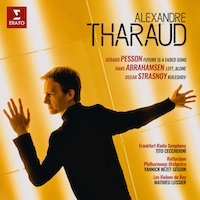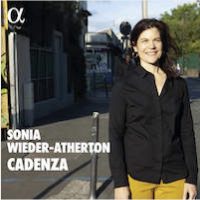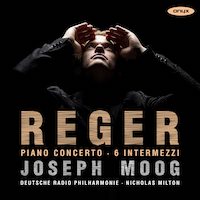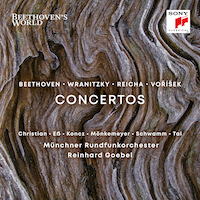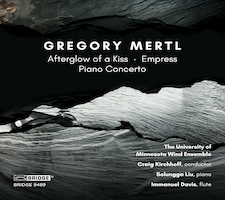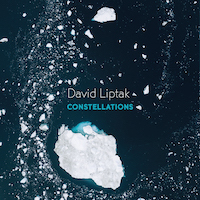Concerto Concentrations 6.
|
Grant Chu Covell [December 2021.]
Hans ABRAHAMSEN: Left, alone (2015)1. Gérard PESSON: Future is a faded song (2012)2. Oscar STRASNOY: Kuleshov (2017)3. Alexandre Tharaud1,2,3 (pno), Rotterdam Philharmonic Orchestra1, Frankfurt Radio Symphony2, Les Violons du Roy3, Yannick Nézet-Séguin1, Tito Ceccherini2, Mathieu Lussier3 (cond.). Erato 9029532307 (1 CD) (www.erato.com). Tharaud brings luminosity to three concertos. Abrahamsen’s is meant for the pianist’s left hand. Actually, it was meant specifically for the composer’s left hand, as Abrahamsen was born with limited functionality of his right hand. He has been able to play piano and horn (which Abrahamsen says is the only instrument that can be played solely with the left hand) and the solo horn figures into this six-movement concerto. The brief movements demand rhythmic precision: The first movement alternates 4/4 and 3/4, alternating quarter note = 145 and = 152 respectively. The percussion’s independent rhythm of seven beats in 4/4 should match five beats in 3/4. The concerto’s austerity persists after repeated listening. Pesson’s concerto is a lengthy unbroken statement for its composer. The title comes from T.S. Eliot, but Pesson intrigues with the notion that Tharaud had commissioned a concerto from Kagel before his death (2008). We know nothing about Kagel’s planned concerto, but Pesson relishes its phantom existence and that there are musical secrets we will never know. Refined and fleeting, Pesson’s concerto gradually unspools from a sparsely employed orchestra like a gigantic prelude waiting for a curtain to be pulled back. At the end, the piano is played with its keyboard covered. Strasnoy’s concerto is the most traditional. Kuleshov was a Soviet filmmaker whose sequencing of unrelated images was intended to create complex emotional responses. Sometimes images would be repeated, and the viewer would think they had changed based upon the intervening material. Strasnoy suggests the Rondo form is a musical version of this technique, and his concerto uses repetitions of long phrases. But are they really identical? If a jovial passage appears after a somber section and then later after a rapid phrase, is it actually the same music? Overall, the jumpy concerto covers much ground, but is less striking than either Abrahamsen or Pesson.
“Cadenza.” Luigi BOCCHERINI: Cello Concerto in D major, G. 479 (ca. 1770; arr. Sonia WIEDER-ATHERTON and Françoise RIVALLAND, 2020)1; Cello Concerto in C major, G. 477 (ca. 1770; arr. WIEDER-ATHERTON and RIVALLAND, 2020)2; Cello Concerto in D major, G. 476 (ca. 1770; arr. WIEDER-ATHERTON and RIVALLAND, 2020)3. Sonia Wieder-Atherton1,2,3 (vlc), Françoise Rivalland1,2,3 (cimbalom), Amaryllis Billet1,2,3 (vln), Robin Billet3 (bsn), Rémi Magnan3 (cbs). Alpha 667 (1 CD) (www.outhere-music.com). Wieder-Atherton’s inventive foray through three Boccherini cello concertos may take some getting used to, even after acclimatizing to her dramatic intonation. The solo cello is accompanied by a single violin and a cimbalom continuo which adds a saucy, folksy feel, but it is the various cadenzas which may bewilder. The cadenzas are emphatic statements, arrangements from material by Eric Dolphy and Miles Davis in the first D major, Michael Riesman, Wieder-Atherton and Rivalland in the C major, and Stravinsky (from Suite Italienne), Kurtág (Un brin de bruyère à Witold) and Handel (from Alcina) in the closing D major. Baroque Boccherini is rolled between modern stuff while the cimbalom plunks and taps like a saloon piano. The last concerto adds bassoon and contrabass to the mix. It’s interesting but will startle those expecting to settle in for a disc of baroque cello music.
Max REGER: Piano Concerto in F minor, Op. 114 (1910). Six Intermezzi, Op. 45 (1900). Joseph Moog (pno), Deutsche Radio Philharmonie, Nicholas Milton (cond.). Onyx ONYX4235 (1 CD) (www.onyxclassics.com). Reger is agreeable, but hardly catchy, an excessively chromatic Brahms but without tunes. Even a less clotted work such as the amenable Clarinet Quintet is hard to love, each successive movement feels hard won. Melodies are there, but they are routinely garnished with extra notes and chords. The Piano Concerto is tough to admire. In three conventional movements, it demands keyboard acrobatics and a visionary to shape the meandering, convoluted arguments. Moog is up to the challenge, comfortably dispatching busy octaves and ornamented sequences. Neither he nor the orchestra sounds lost or overwhelmed amid the questioning and busy polyphony. The Six Intermezzi are elaborate considering their modest scale. Navigating the gallant twists, Moog applies delicacy, just a few hairs shy of grandiose parody.
“Beethoven’s World.” Ludwig van BEETHOVEN: Concerto in C major for Violin and Orchestra, WoO 5 (1792; compl. Joseph HELLMESBERGER, 1879)1. Anton WRANITZKY: Concerto in C major for Two Violas and Orchestra (1805)2. Antonín REICHA: Solo de Cor Alto in G major for Horn and Orchestra (1823)3. Jan Václav VOŘÍŠEK: Grand Rondeau Concertant for Piano, Violin, Cello and Orchestra, Op. 25 (1820)4. Sarah Christian1,4 (vln), Nils Mönkemeyer2, Teresa Schwamm2 (vla), Christoph Eß3 (hrn), Yaara Tal4 (pno). Münchner Rundfunkorchester1,2,3,4, Reinhard Goebel1,2,3,4 (cond.). Sony 19075929662 (1 CD) (www.sonyclassical.com). Goebel’s enjoyable series continues. First off, no jokes about a concerto for two violas. Wranitzky’s double is accomplished and serious. Maybe the Rondo’s theme comes close to Mozart but not quite. Orchestral expositions precede the soloists’ appearance who joust agreeably. Contrasting Wranitzky with the Beethoven fragment, the violin surprisingly curtails the exposition which is why we still talk about Beethoven and not the others. Reicha’s concerto is a charming showpiece for horn. Voříšek’s “triple” proceeds grandly, but it’s impossible not hear the trio recognizing its gentle frivolity.
Gregory MERTL: Afterglow of a Kiss (2000)1; Empress (1998)2; Piano Concerto (2008-10)3. Immanuel Davis1 (fl), Solungga Liu3 (pno), University of Minnesota Wind Ensemble1,2,3, Craig Kirchhoff1,2,3 (cond.). Bridge Records 9489 (1 CD) (www.bridgerecords.com). Afterglow of a Kiss is a lively flute concertino which asks for energy from soloist and ensemble. Winds plus ample percussion and string quintet are creatively scored. Mertl is coy about his titles, and we must use the music to determine if there is a story and what if any the emotions might be. Empress’ title is similarly allusive. The notes mention a dedication to Angela Wellman, and that’s it. The piece opens mysteriously, gradually transforming its energy. We may be in the dark recesses of an early Stravinsky ballet, except Mertl’s one-on-a-part scoring produces crispness. Clear wind writing carries into the Piano Concerto. Contrasting the traditional concerto concept, the soloist discovers herself as the movements progress, offering fragments and timid ideas in the first movement, paired equally with the ensemble in the center movement, “Coupling,” and finally a propulsive force in the last movement. Stravinsky again comes to mind, but Mertl is never ironic, and does not settle for simplistic textures. This is one of those rare recordings where strings are not missed.
David LIPTAK: Concerto for Piano and Percussion Orchestra (2018); Constellations (2010). Eunmi Ko (pno), McCormick Percussion Group, Robert McCormick (cond.). Innova 031 (1 CD) (www.innova.mu). The nine parts of Constellations are delicate and clever, a solo work far more engaging than the indifferent Concerto whose percussion backing seems a colorless afterthought. The Concerto is in a slow-fast-slow structure, the percussion ensemble going its own way in terms of rhythmic and pitched material. If the piano writing in the Concerto is abrasive and muscular, Constellations affords more opportunities for transparent textures, with interesting patterns and gestures. The distance between the two works suggests different composers or divergent aesthetics. Ko is busier in the Concerto but has more to say in Constellations.
Abrahamsen, Beethoven, Boccherini, Dolphy, Handel, Hellmesberger, Kurtág, Liptak, Mertl, Miles Davis, Pesson, Reger, Reicha, Riesman, Rivalland, Strasnoy, Stravinsky, Vorisek, Wieder-Atherton, Wranitzky
[More
Abrahamsen, Beethoven, Boccherini, Dolphy, Handel, Hellmesberger, Kurtág, Liptak, Mertl, Miles Davis, Pesson, Reger, Reicha, Riesman, Rivalland, Strasnoy, Stravinsky, Vorisek, Wieder-Atherton, Wranitzky]
[Previous Article:
Mostly Symphonies 39. / EA Bucket 32: Pierre Henry +/- Beethoven]
[Next Article:
(Dis)Arrangements 13. / Scarlatti para siempre 3.]
|
